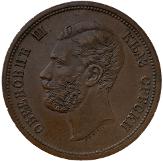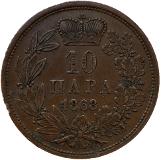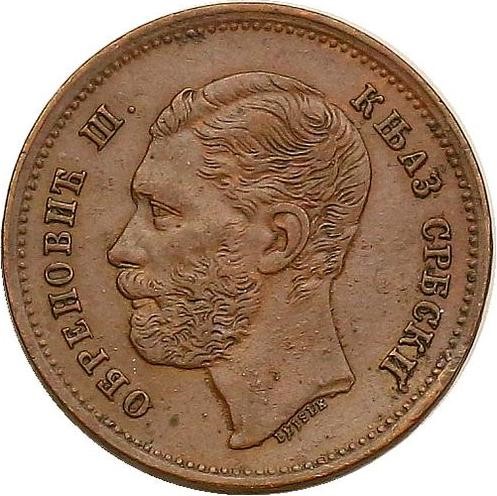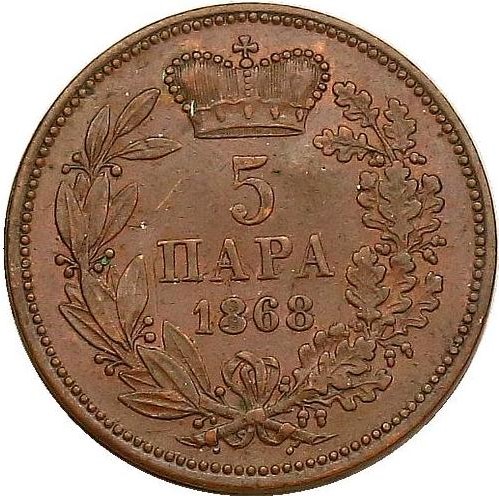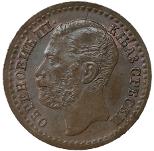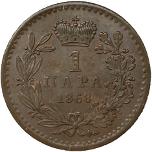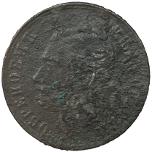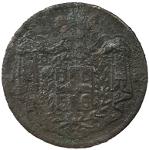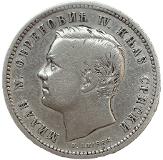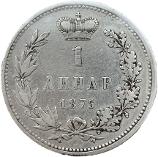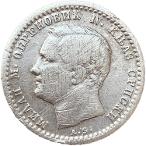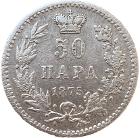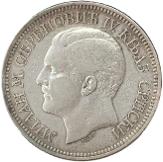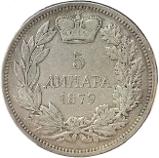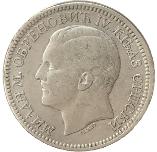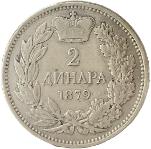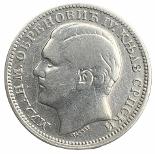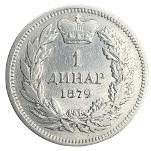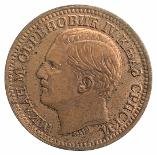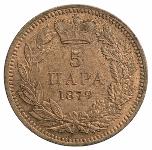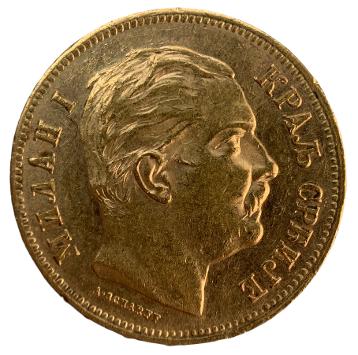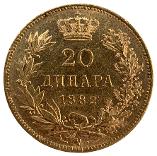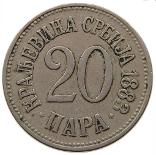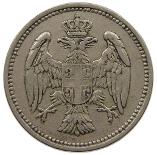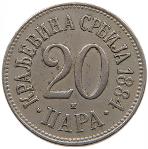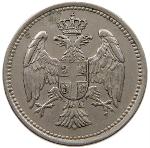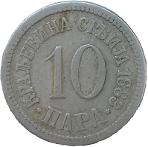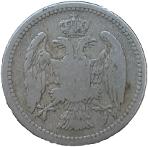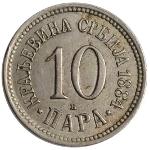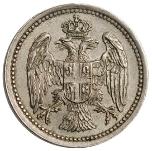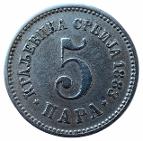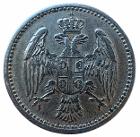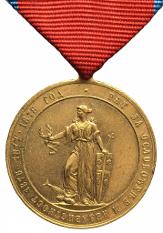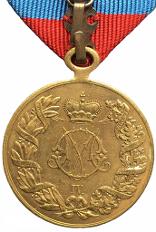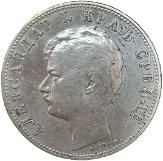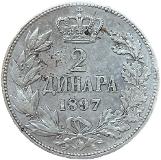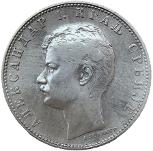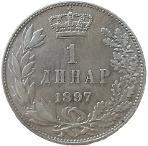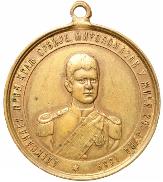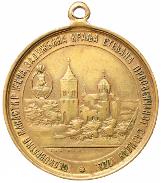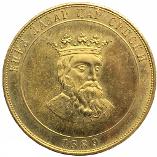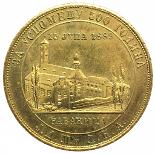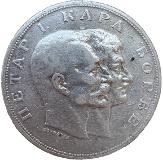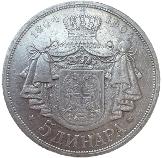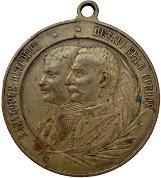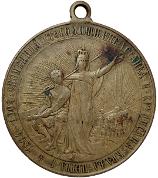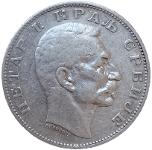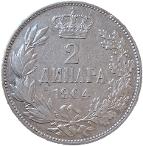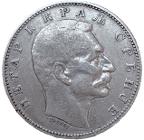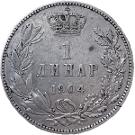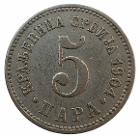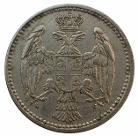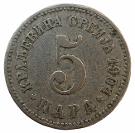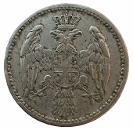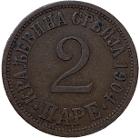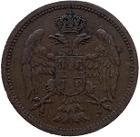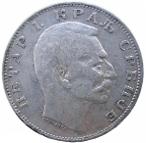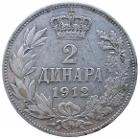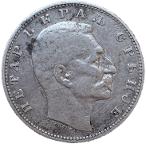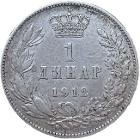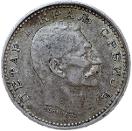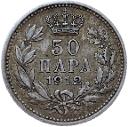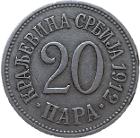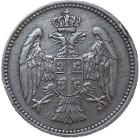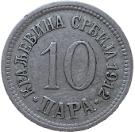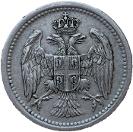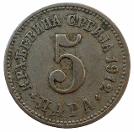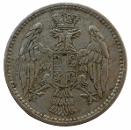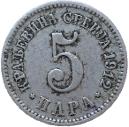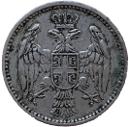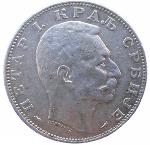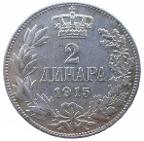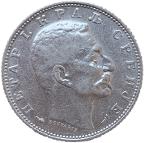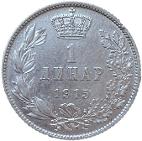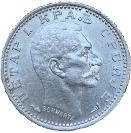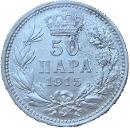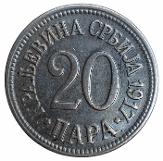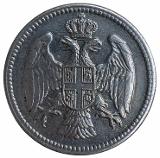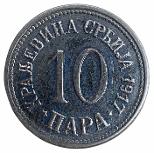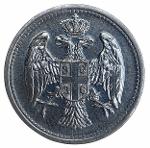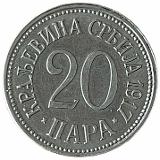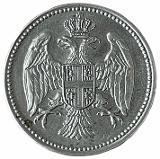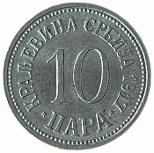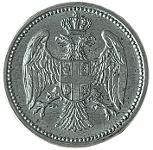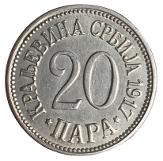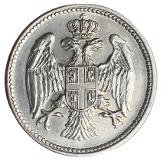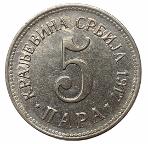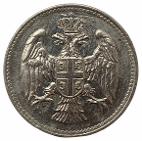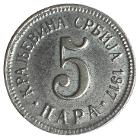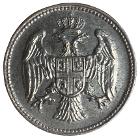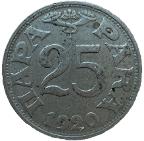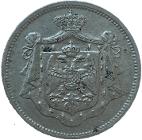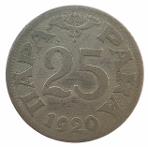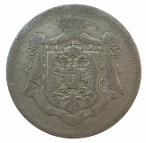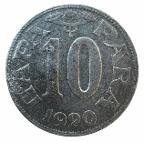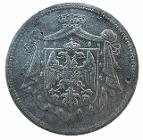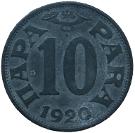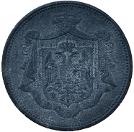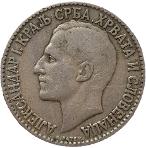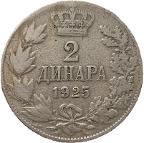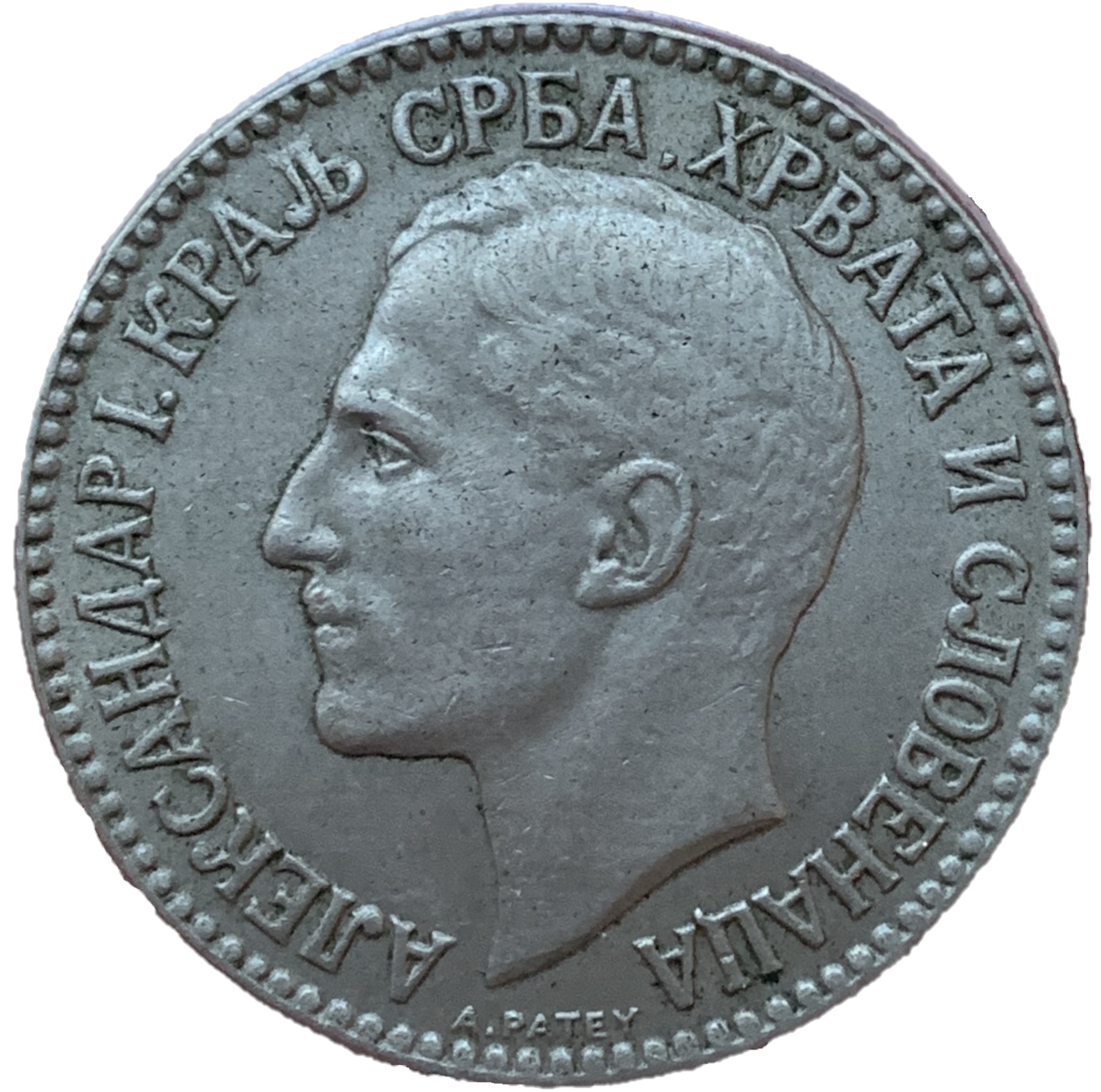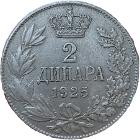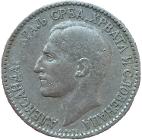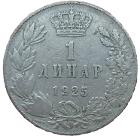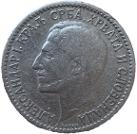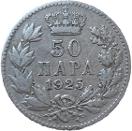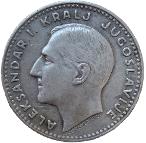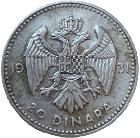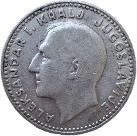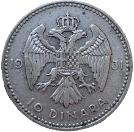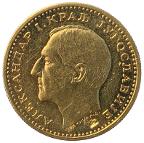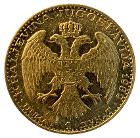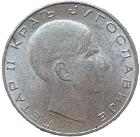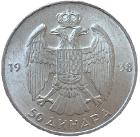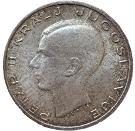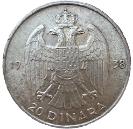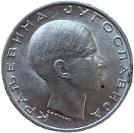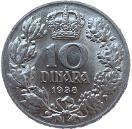After the loss of Despotate in 1459, Serbian kingdom continued to exist in exile in the medieval Kingdom of Hungary until the mid-16th century and fight Ottomans for years constantly until the Principality of Serbia was established in 1815.
Stefan Tomašević or Stefan II (around 1430 - 25 May 1463) was the last sovereign from the Bosnian Kotromanić dynasty, reigning as Despot of Serbia briefly in 1459 (1 April 1459 – 20 June 1459) and as King of Bosnia from 1461 until 1463.
Vuk Grgurević Branković (1440 – April 16, 1485) was a Serbian nobleman who was the titular despot of Serbia from 1471 until his death in 1485. He inherited the title of despot by King Matthias Corvinus and ruled most of present-day Vojvodina, under the oversight of the Kingdom of Hungary. He is known in Serbian epic poetry for his valor and heroism, and is called Vuk the Fiery Dragon (Serbian: Zmaj Ognjeni Vuk), Vuk the Dragon-Despot, or simply the Dragon, commanded the Hungarian army (Black Army) in several of its battles against the Ottomans. He is considered the founder of Grgeteg monastery.
Đorđe Branković (1461 – 1516) was the last male member of the Branković dynasty, and titular Despot of Serbia from 1486 to 1497. The title was granted to him by Hungarian king Matthias Corvinus. From 1493, he shared the title with his brother Jovan. In 1497, Đorđe relinquished all titles and possessions to his brother, and decided to take monastic vows, adopting the name Maksim. He built the Krušedol monastery, and served as diplomatic envoy for prince Radu IV the Great of Wallachia (1507). In 1513, he became Metropolitan of Belgrade.
Jovan Branković (1465 - died 10 December 1502) was the titular Despot of Serbia from 1493 until his death in 1502. Title of despot was given to him by Hungarian king Vladislas II of Hungary. From 1493 to 1497 he held the title together with his elder brother Đorđe Branković, who was despot since 1486. In 1497, Đorđe relinquished the title, and Jovan remained the sole Despot of Serbia, until his death in 1502. Jovan was the last Serbian Despot of the Branković dynasty.
Ivaniš Berislavić was the Despot of the Kingdom of Serbia from 1504 to 1514. He was married to Jelena Jakšić who was the daughter of Stefan Jakšić (died in 1489), of the Jakšić noble family.
Stefan Berislavić (1505 - 1535) was titular Despot of Serbia, between 1520 and 1535, and a prominent nobleman in southern counties (Syrmia, Valkó and Požega) of the Kingdom of Hungary.
Pavle Bakić (1484 - 9 October 1537) was the last Despot of Serbia to be recognized by both the Ottoman and the Habsburg Monarchy.
He was one of the most notable military commanders among Serbian nobility in the Kingdom of Hungary, and fought against the Ottoman Empire in several battles, most notably at the Battle of Mohács (1526) and the Battle of Vienna (1529). He fell at the Battle of Gorjani (1537).
During the Siege of Vienna in 1529, Serbian hussars under the command of Pavle Bakić were the first to engage the Turks when they attacked the capital. A charter of king Ferdinand, dated September 20, 1537, designates Pavle Bakić as the new Despot, and calles all Serbs to join and follow Bakić as the Serbian Despot.
The Uprising in Banat was a rebellion organized and led by Serbian Orthodox bishop Teodor of Vršac and Sava Temišvarac against the Ottomans in the Eyalet of Temesvar. The uprising broke out in 1594, in the initial stage of the Long Turkish War, and was fought by local Serbs, numbering some 5,000, who managed to quickly take over several towns in the region before being crushed by the Ottoman army. The relics of Saint Sava were burnt by the Ottomans as a retaliation. Although short-lived, it inspired future rebellions.
The Serb uprising of 1596–1597, also known as the Herzegovina uprising of 1596–1597, was a rebellion organized by Serbian Patriarch Jovan Kantul (1592–1614) and led by Grdan, the vojvoda ("duke") of Nikšić against the Ottomans in the Sanjak of Herzegovina and Montenegro, during the Long Turkish War (1593–1606). The uprising broke out in the aftermath of the failed Banat Uprising in 1594 and the burning of Saint Sava's relics on April 27, 1595; it included the tribes of Bjelopavlići, Drobnjaci, Nikšić, and Piva. The rebels, defeated at the field of Gacko (Gatačko Polje) in 1597, were forced to capitulate due to a lack of foreign support.
After the failure of the uprising, many moved to the Bay of Kotor and Dalmatia. The earliest more significant Serb migrations took place between 1597 and 1600. Grdan and Patriarch Jovan would continue to plan revolts against the Ottomans in the coming years. Jovan contacted the pope again in 1599, without success. Serbian, Greek, Bulgarian, and Albanian monks visited European courts to solicit help. The first decade of the 17th century saw some successful Montenegrin battles against the Ottomans under Metropolitan Rufim. The tribe of Drobnjaci defeated the Ottomans in Gornja Bukovica on 6 May 1605. However, Ottomans retaliated the same summer and captured the duke Ivan Kaluđerović who was eventually taken to Pljevlja and executed. From the assembly in Kosijerevo monastery, on 18 February 1608, Serb leaders urged the Spanish and Neapolitan court for final energetic action. Preoccupied, Spain could not do much in Eastern Europe. However, the Spanish fleet did attack Durrës in 1606. Finally, on 13 December 1608, Patriarch Jovan Kantul organized an assembly in Morača Monastery gathering all the rebel leaders of Montenegro and Herzegovina. The assembly officially negotiated with Emmanuel I to send a force for the liberation of the Balkans, in exchange for "the Crown of Macedonia", at the same time requesting that Pope Paul grant the Serbian Orthodox Church special privileges. "In our parts," they demanded, "we do not want any Jesuits, or anyone else, who intends on turning the Christian folk to Roman law." Jovan assured him that an army of 20,000, 25 guns, and weapons for 25,000 more to be distributed in the Balkans would overwhelm the Ottoman sultan. After years of planning, nothing concrete resulted in it, because such an operation "required Spanish naval and logistical support". The rebellion slowly faded through 1609 towards the end of 1610.
The 1596–97 uprising would stand as a model for multiple anti-Ottoman uprisings in Serbia and Bosnia in the coming centuries.
In 1683, the Great Vienna War broke out between the Ottoman Empire and the Habsburg Monarchy. After the victory in the Siege of Buda (1686), Habsburg forces continued their advance towards south, forcing Ottomans to retreat from the Kingdom of Hungary and neighboring regions. In the same time, local Serbs, who were Christians, formed the Serbian Militia and joined with Habsburg forces against Ottomans, driving them out (fully or partially) from regions of Bačka, Banat and Syrmia (corresponding to modern Vojvodina, in Serbia).
Habsburg-occupied Serbia refers to the period between 1686 and 1699 of the Great Turkish War, during which various regions of Serbia were occupied by the Habsburg Monarchy. In those regions, Habsburg authorities have established various forms of provisional military administration, including the newly organized Serbian Militia. By the Treaty of Karlowitz in 1699, some of those regions remained under the permanent Habsburg rule, while others were returned to the Ottoman Empire.
The Kingdom of Serbia was a province (crownland) of the Habsburg Monarchy from 1718 to 1739. It was formed from the territories to the south of the rivers Sava and Danube, corresponding to the Sanjak of Smederevo (or "Belgrade Pashaluk"), conquered by the Habsburgs from the Ottoman Empire in 1717. It was abolished and returned to the Ottoman Empire in 1739.
The Serb Uprising of 1737–1739 broke out following Austria's defeats against the Ottomans, when the Austrian Emperor issued proclamations that the Christians in the Balkans rise against the Ottoman Empire. The Austrian Emperor called on the Serbs, who were ready to revolt on 15th June 1737, and stressed that they would fight in an alliance with Russia against a common enemy. The Serbs organized themselves under Serbian Patriarch Arsenije IV. The uprising had a wide geographical extent, from Belgrade to eastern Bosnia and Herzegovina, Montenegro and the Šar Mountain. The Albanian Klimenti tribe also joined the uprising. The failed war prompted Serbs, mostly from Herzegovina, Sandžak, Metohija and Montenegro, to flee under the leadership of Arsenije IV from the Ottoman territories into the Habsburg Monarchy (as was done in 1689–92).
Koča's frontier (Serbian: Кочина крајина / Kočina krajina) refers to the Serbian territory established in the Sanjak of Smederevo, Ottoman Empire, during the Austro-Turkish War (1787–1791). The Habsburg-organized Serbian Free Corps, among whom Koča Anđelković was a prominent captain, initially held the central part of the sanjak, between February and September 7, 1788, after the Austrians entered the conflict the territory was expanded and became a Habsburg protectorate under military administration, called Serbia. After the Austrian withdrawal and Treaty of Sistova (1792), the territory was regained by the Ottomans.
The First Serbian Uprising was an uprising of Serbs in the Sanjak of Smederevo against the Ottoman Empire from 14 February 1804 to 7 October 1813. Initially a local revolt against renegade janissaries who had seized power through a coup, it evolved into a war for independence (the Serbian Revolution) after more than three centuries of Ottoman rule and short-lasting Austrian occupations.
The Second Serbian Uprising was the second phase of the Serbian Revolution against the Ottoman Empire, which erupted shortly after the re-annexation of the country to the Ottoman Empire in 1813. The occupation was enforced following the defeat of the First Serbian Uprising (1804–1813), during which Serbia existed as a de facto independent state for over a decade. The second revolution ultimately resulted in Serbian semi-independence from the Ottoman Empire. The Principality of Serbia was established, governed by its own parliament, constitution and royal dynasty. De jure independence, however, was attained in 1878, following the decisions of the Congress of Berlin.
Principality of Serbia 1815–1882
Title: Prince of Serbia
1) Miloš Obrenović I (1817-1839 and 1858-1860)
2) Miloš Obrenović II (25 June to 8 June 1839)
3) Mihailo Obrenović III (1939-1942 and 1860-1868)
4) Aleksandar Karađorđević (1842-1858)
5) Milan Obrenović IV (1868-1882)
Kingdom of Serbia (1882–1918)
Title: King of Serbia
1) Milan Obrenović IV or Milan I (1882-1889).
2) Alexander I or Aleksandar Obrenović (1889-1903)
3) Peter I or Petar I Karađorđević (1903–1918)
Kingdom of Serbs, Croats and Slovenes, (Yugoslavia was its colloquial name) (1918-1929) then officially as Kingdom of Yugoslavia (1929-1945)
Title: King of Serbs, Croats and Slovenes and then King of Yugoslavia
1) Peter I or Petar I Karađorđević (1918–1921)
2) Aleksandar I Karađorđević (1921-1929-1934)
3) Peter II Karađorđević (1934-1945)
Following collection are coins issued from 1868 to 1945.
Mihailo Obrenović III (1839-1842, 1860-1868). Year: 1868.
Value: 10 Para (0.1), Currency: Dinar (1868-1918), Composition: Bronze, Weight: 10g, Diameter: 30mm, Mintage: 6,590,000.
Value: 5 Para (0.05), Currency: Dinar (1868-1918), Composition: Bronze, Weight: 5g, Diameter: 25mm, Mintage: 7,420,000.
Value: 1 Para (0.01), Currency: Dinar (1868-1918), Composition: Bronze, Weight: 1g, Diameter: 15mm, Mintage: 7,500,000.
Value: 1 Para, Currency: Earlier test (Proba), Composition: Bronze, Weight: 0.9g, Diameter: 16mm. Coat of Arms of the Obrenovic family on the reverse.
Obverse: Obrenović III facing left. Serbian legend: ОБРЕНОВИЋ III. КЊАЗ СРБСКИ (Obrenović III Prince of Serbia).
Engraver: Anton Karl Rudolf Scharff (born June 10th, 1845 in Vienna , died July 5th, 1903 in Brunn am Gebirge) was an Austrian medalist.
Reverse: Denomination and date within wreath, crown above. Serbian legend: 10 ПАРА 1868.
Comments: These issues are the first currency, first coins since medieval times, since 15th century.
Milan Obrenović IV (1868-1889). Year: 1875
Value: 1 Dinar (1), Currency: Dinar (1875-1918), Composition: Silver (.835), Weight: 5g, Diameter: 23mm, Mintage: 3,000,000.
Value: 50 Para (0.5), Currency: Dinar (1875-1918), Composition: Silver (.835), Weight: 2.5g, Diameter: 18mm, Mintage: 2,000,000.
Obverse: Milan Obrenović IV facing left. Serbian legend: МИЛАН М. ОБРЕНОВИЋ IV. КЊАЗ СРПСКИ (Milan M. Obrenović IV Prince of Serbia).
Engraver: Freidrich (Franz) Leisek was Austrian engraver and medalist at Vienna, 1868-1892; died there in 1898.
Reverse: Denomination and date within wreath, crown above. Serbian legend: 1 ДИНАР 1875.
Comment: Milan Obrenović (22 August 1854 – 11 February 1901) was the ruler of Serbia from 1868 to 1889, first as Prince Milan Obrenovic IV (1868-1882) and then as King Milan I (1882-1889).
This is the first silver Serbian coin since the coins of Brankovic family in the 15th century.
Milan Obrenović IV (1868-1889). Year: 1879
Value: 5 Dinara (5), Currency: Dinar (1879-1918), Composition: Silver (.900), Weight: 25g, Diameter: 37mm, Mintage: 200000.
Obverse: Milan Obrenović IV facing left. Serbian legend: МИЛАН М. ОБРЕНОВИЋ IV. КЊАЗ СРПСКИ (MILAN OBRENOVIC IV PRINCE OF SERBIA), TASSET (Engraver: Ernest Paulin Tasset, was French sculptor and medalist, born in Paris on November 15th 1839 and died in the same town on November 22nd 1921).
Reverse: Denomination and date within wreath, crown above. Serbian legend in 3 rows: 5 ДИНАРА 1879.
Edge Lettering: This is Type 1: БОГ*ЧУВА*СРБИЈУ*** (KM# 12). There is also Type 2: БОГ*СРБИЈУ*ЧУВА*** (KM# 13). Translation: GOD PROTECTS SERBIA.
---------------------------------------------------------------------------------------------------------------------------------------------------
Value: 2 Dinara (2), Currency: Dinar (1879-1918), Composition: Silver (.835), Weight: 10g, Diameter: 27mm, Mintage: 750,000.
Value: 1 Dinar (1), Currency: Dinar (1879-1918), Composition: Silver (.835), Weight: 5g, Diameter: 23mm, Mintage: 800,000.
Value: 10 Para (0.1) 1879, Currency: Dinar (1879-1918), Composition: Bronze, Weight: 10g, Diameter: 30mm, Mintage: 9,000,000.
---------------------------------------------------------------------------------------------------------------------------------------------------
Value 20 Dinara (20) 1882, Currency Dinar (1868-1918), Composition Gold (.900), Weight 6.45161g, Diameter 21mm, Mintage: 300,000.
Obverse: Milan I facing right. Serbian legend: МИЛАН I КРАЉ СРБИЈЕ (MILAN I KING OF SERBIA) A•SCHARFF (Engraver: Anton Scharff).
Reverse: Denomination and date within wreath, crown above. Serbian legend in 3 rows: 20 ДИНАРА 1882, V on the bottom for Vienna mint.
Edge Inscribed: This is Type 1: БОГ*ЧУВА*СРБИЈУ*** (KM#17.1). There is also Type 2: БОГ*СРБИЈУ*ЧУВА (KM#17.2). Translation: GOD PROTECTS SERBIA.
---------------------------------------------------------------------------------------------------------------------------------------------------
Value: 20 Para (0.2) 1883, Currency: Dinar (1879-1918), Composition: Copper-nickel, Weight: 5.6g, Diameter: 22mm, Mintage: 2,500,000. Coat of Arms.
Value: 10 Para (0.1) 1883, Currency: Dinar (1879-1918), Composition: Copper-nickel, Weight: 4g, Diameter: 20mm, Mintage: 5,000,000. Coat of Arms.
Value: 5 Para (0.05) 1883, Currency: Dinar (1879-1918), Composition: Copper-nickel, Weight: 3g, Diameter: 17mm, Mintage: 4,000,000. Coat of Arms.
Value: 20 Para (0.2) 1884 H, Currency: Dinar (1879-1918), Composition: Copper-nickel, Weight: 5.6g, Diameter: 22mm, Mintage: 6,000,000. Coat of Arms.
Value: 10 Para (0.1) 1884 H, Currency: Dinar (1879-1918), Composition: Copper-nickel, Weight: 4g, Diameter: 20mm, Mintage: 6,500,000. Coat of Arms.
Medal on the right:
Is The Commemorative Medal for the Serbian – Turkish Wars of 1876 – 1878 that was awarded to all persons who had taken part in the wars of 1876, and 1877/78 as combatants or non-combatants in recognition of sacrifices made and services rendered for independence and liberation. This example was awarded to combatants on a red ribbon with blue edges.
The medal has a diameter of 33mm. The obverse bears the crowned monogram of Prince Milan Obrenovic ‘MO IV’, surrounded by a laurel (left) and oak (right) branch. The branches are twisted around a bandeau bearing an inscription commemorating the major battles of the Serbian - Turkish Wars. The names ШУМАДОВАЦ / НИШ / АКПАЛАНКА / ПИРОТ (Shumatovac/Nish/Ak Palanka/Pirot) are placed on the left and ГРДЕЛИЦА / ВРАЊА / СТ НИКОЛА / АДЛИЈЕ (Grdelica/Vranja/St. Nikola/Adlije) on the the right. The reverse of the medal shows an allegorical figure of a standing woman, symbolizing Serbian victory, and holding a laurel branch in one hand and a cross in the other. The figure is leaning on a shield with the Serbian coat of arms. The Turkish flag and military trophies are placed under her feet. The central motif is surrounded by a border with the Cyrillic inscription: РАТ ЗА ОСЛОБОЂЕЊЕ И НЕЗАВИСНОСТ 1876-1877-1878 (War for Liberation and Independence 1876-1877-1878).
King Alexander I Obrenović (1889-1903). Year: 1897.
Value: 2 Dinara (2), Currency: Dinar (1897-1918), Composition: Silver (.835), Weight: 10g, Diameter: 28mm, Mintage: 1,000,000.
Value: 1 Dinar (1), Currency: Dinar (1897-1918), Composition: Silver (.835), Weight: 5g, Diameter: 23mm, Mintage: 4,001,000.
Obverse: Portrait of Aleksandar I facing left. Serbian legend: АЛЕКСАНДАР I. КРАЉ СРБИЈЕ (Aleksandar I, King of Serbia). A.SCHARFF
Engraver: Anton Scharff (1845-1903), an Austrian medalist born in Vienna.
Reverse: Denomination and date. Serbian legend: 1 ДИНАР 1897.
Comment: King Alexander I Obrenović (14 August 1876 – 29 May 1903) was king of Serbia from 1889 to 1903 when he and his wife, Draga Mašin, were assassinated by a group of Royal Serbian Army officers, led by Captain Dragutin Dimitrijević.
Medal on the left:
Anointment of Alexander Obrenović, King of Serbia; June 20, 1889 commemorative medal. Bronze partial gilding. Known designer/maker of this medal was Adolf Müller in Vienna. 37mm, planchet 2.8mm thick.
King Alexander I Obrenović in military uniform, circumscribed ‘АЛЕКСАНДЕР ПРВИ, КРАЉ СРБИЈЕ, МИРОПОМАЗАН У ЖИЧИ 20 ЈУНА 1889.’ (Alexander the First, King of Serbia, Anointed at Žica, 20 June 1889); the reverse with a view of Žica Monastery, a small oval with the portrait of King Stefan I Nemanja above left, circumscribed ‘СЕДМОВРАТНИ МАНАСТИР ЖИЧА ЗАДУЖБИНА КРАЉА СТЕВАНА ПРВОВЕНЧАНОГ, САЗИДАН 1222.’(Seven-cupola Monastery of Žica, Legacy of King Stefan the First, Crowned, Built 1222.), signed ‘ИЗД M.A.M.’; on replaced correct trifold ribbon.
The medal was created to be given to the dignitaries attending the anointment at Žica of King Alexander I Obrenović on 20 June (2 July) 1889 and was later awarded to members of the Serbian Army on the occasion of Alexander I declaring his Regency to be at an end in 1893. In 1889, King Milan IV Obrenović abdicated the Serbian throne, leaving his 13 year-old son Alexander as king under a Regency headed by his mother. In 1893 he declared himself of age and abolished the Regency, appointing a radical government. A year later, he abolished democratic government and a decade of misrule followed. It was his marriage to Madame Draga Mašin, a former lady-in-waiting to his mother, Queen Natalia, however, that finally caused the disaffection of the army to be transformed into action and Alexander and Draga were murdered on 11 June 1903.
Stefan Nemanja (1117-1199) ruled over a medieval Serbian state and towards the end of his life retired. The ceremony at Žica took place 500 years after the Battle of Kosovo in 1389.
Medal on the right:
The 500th Anniversary of the Battle of Kosovo Medal 1389-1889
Medal is in brass, obverse illustrating the bust of Serbian Prince Lazar Hrebeljanović, surrounded by a circle inscribed "КНЕЗ ЛАЗАР ЦАР СРПСКИ" above and dated "1389" below, reverse illustrating the Ravanica, the Serbian Orthodox monastery, dated "15 ЈУНА 1889" (June 15, 1889) above and inscribed "РАВАНИЦА" (Ravanica) below the monastery, surrounded by a circle inscribed "ЗА УСПОМЕНУ 500 ГОДИНА" above and "Ј.Д.М.и Л.К.А." below, measuring 28.3 in diameter.
Serbian Coat of Arms on the officers belt buckle from the time of King Alexander I Obrenović (14 August 1876 – 29 May 1903).
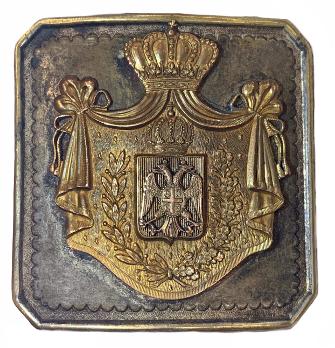
King Peter I Karadjordjevic (1903-1918). Year: 1904
Value: 5 Dinara (5), Currency: Dinar (1904-1918), Composition: Silver (.900), Weight: 25g, Diameter: 37mm, Mintage: 200,000. Commemorative issue 100th Anniversary of the Karadjordjević Dynasty.
Value: 2 Dinara (2), Currency: Dinar (1904-1918), Composition: Silver (.835), Weight: 10g, Diameter: 28mm, Mintage: 1,150,044.
Value: 1 Dinara (1), Currency: Dinar (1904-1918), Composition: Silver (.835), Weight: 5g, Diameter: 21.5mm, Mintage: 2,000,086.
Value: 5 Para (0.05), Currency: Dinar (1904-1918), Composition: Copper-nickel, Weight: 3g, Diameter: 17mm, Mintage: 8,000,000.
Value: 2 Pare (0.02), Currency: Dinar (1904-1918), Composition: Bronze, Weight: 2g, Diameter: 20mm, Mintage: 12,500,000.
Obverse: Petar I and Karadjordje facing right. Serbian legend: ПЕТАР I КАРА-ЂОРЂЕ (Petar I and Karadjordje). Signature under bust: SCHWARTZ
Engraver: Stefan Schwartz (1851-1924) an Austrian sculptor and medalist.
Reverse: Serbian legend: 1804 1904 * 5 ДИНАРА *. Coat of arms with a shield with double headed eagle, 4 Cs (САМО СЛОГА СРБИНА СПАШАВА - ONLY UNITY SAVES SERBIAN) and 2 lilies at the bottom.
Edge Lettering: ***** БОГ * ЧУВА * СРБИJУ (GOD SAVE SERBIA).
Comment: Peter I (11 July [or 29 June] 1844 – 16 August 1921) reigned as the last King of Serbia (1903–1918) and as the first King of the Serbs, Croats and Slovenes (1918–1921). Since he was the king of Serbia during a period of great Serbian military success, he was remembered by the Serbian people as King Peter the Liberator, and also known as Old King.
Peter was Karađorđe's grandson and third son of Persida Nenadović and Prince Alexander Karađorđević, who was forced to abdicate. Peter lived with his family in exile. He fought with the French Foreign Legion in the Franco-Prussian War. He joined as volunteer under the alias Peter Mrkonjić in the Herzegovina Uprising (1875–77) against the Ottoman Empire.
He married Princess Zorka of Montenegro, daughter of King Nicholas, in 1883. She gave birth to his five children, including Prince Alexander. After the death of his father in 1885, Peter became head of the Karađorđević dynasty. After a military coup d'état and the murder of King Alexander I Obrenović in 1903, Peter became King of Serbia.
Bronze or copper medal with loop for ribbon suspension.
Obverse: the portraits of Karađorđe Petrović and King Petar I, a laurel branch below. Serbian legend: КАРАЋОРЋЕ ПЕТРОВИЋ * * ПЕТАР I КРАЉ СРБИЈЕ (Karađorđe Petrović * * Petar I King of Serbia), signed ВТ (for the designer Vladislav Titelbah).
Reverse: Seated soldier and a standing female figure representative of Serbia holding a flag, her left arm aloft, a radiant rising sun and the Monastery of Žica in the background. Serbian legend: 1804-1904. СПОМЕНИЦА СТОГОДИШЊИЦЕ УСТАНКА И КРУНИСАЊА КРАЉА ПЕТРА I (1804-1904 Commemoration of the Centenary of the Insurrection and the Coronation of King Petar I).
Comment: This unofficial medal was commissioned and paid for by a number of Serbian patriotic associations to commemorate the centenary of the first Serb uprising against Ottoman rule in 1804 and the coronation of King Petar I Karađorđević. Vladislav Titelbah (1842-1927), designer of the medal, was a noted Serbian painter and graphic artist who conducted much research on Serbian folk art and, in particular, the artefacts of medieval Serbia.
King Peter I Karadjordjevic (1903-1918). Year: 1912
Value: 2 Dinara (2), Currency: Dinar (1912-1918), Composition: Silver (.835), Weight: 10g, Diameter: 28mm, Mintage: 800 016.
Value: 1 Dinara (1), Currency: Dinar (1912-1918), Composition: Silver (.900), Weight: 5g, Diameter: 22.5mm, Mintage: 8,000,000.
Value: 50 Para (0.5), Currency: Dinar (1912-1918), Composition: Silver (.835), Weight: 2.5g, Diameter: 18mm, Mintage: 800,000.
Value: 20 Para (0.2), Currency: Dinar (1912-1918), Composition: Copper-nickel, Weight: 5.6g, Diameter: 22mm, Mintage: 5,650,032.
Value: 10 Para (0.1), Currency: Dinar (1912-1918), Composition: Copper-nickel, Weight: 4g, Diameter: 20mm, Mintage: 7,700,032.
Value: 5 Para (0.05), Currency: Dinar (1912-1918), Composition: Copper-nickel, Weight: 3g, Diameter: 17mm, Mintage: 10,500,032.
Obverse: Portrait of Petar I facing right. Serbian legend: ПЕТАР I. КРАЉ СРБИЈЕ (Petar I King of Serbia), SCHWARTZ.
Engraver: Stefan Schwartz (1851-1924) an Austrian sculptor and medalist.
Reverse: Denomination and date. Serbian legend: 1 ДИНАР 1912.
Comment: As king, he advocated a constitutional setup for the country and was famous for his libertarian politics. Rule of king Peter was marked with great exercise of political liberties, freedom of press, national, economical and cultural rise, and it is sometimes dubbed "golden" or "Periclean age".
King Peter was the supreme commander of the Serbian army in the Balkan wars. Because of his age, on 24 June 1914, he proclaimed his son, Alexander, heir-apparent to the throne, as regent.
The First Balkan War began in October 1912 and ended in May 1913. It involved military actions of the Balkan League (Bulgaria, Serbia, Greece and Montenegro) against the Ottoman Empire. The combined armies of the Balkan states overcame the numerically inferior and strategically disadvantaged Ottoman armies and achieved rapid success. As a result of the war, the allies captured and partitioned almost all remaining European territories of the Ottoman Empire.
Dissatisfied with its share of the spoils of the First Balkan War, Bulgaria attacked its former allies, Serbia and Greece, and started the Second Balkan War on 16/29 June 1913. Serbian and Greek armies repulsed the Bulgarian offensive and counter-attacked, entering Bulgaria. With Bulgaria also having engaged in territorial disputes with Romania, this war provoked Romanian intervention against Bulgaria. The Ottoman Empire took advantage of the situation to regain some territories lost as a result of the previous war. When Romanian troops approached the Bulgarian capital, Sofia, Bulgaria asked for an armistice, resulting in the 1913 Treaty of Bucharest, in which Bulgaria had to cede portions of its First Balkan War gains to Serbia, Greece and Romania. The Second Balkan War left Serbia as the most militarily powerful state south of the Danube. Years of military investment financed by French loans had borne fruit. Central Vardar and the eastern half of the Sanjak of Novi Pazar were acquired. Its territory grew in extent from 18,650 to 33,891 square miles and its population grew by more than one and a half million.
King Peter I Karadjordjevic (1903-1918). Year: 1915
Value: 2 Dinara (2), Currency: Dinar (1915-1918), Composition: Silver (.835), Weight: 10g, Diameter: 28mm, Mintage: 825 858.
Value: 1 Dinara (1), Currency: Dinar (1915-1918), Composition: Silver (.900), Weight: 5g, Diameter: 22.5mm, Mintage: 10,688,711. Without designer's name 2,312,304.
Value: 50 Para (0.5), Currency: Dinar (1912-1918), Composition: Silver (.835), Weight: 2.5g, Diameter: 18mm, Mintage: 12,137,928. Without designer's name 1,862,071.
Obverse: Portrait of Petar I facing right.
Serbian legend: ПЕТАР I. КРАЉ СРБИЈЕ (Petar I King of Serbia), SCHWARTZ.
Engraver: Stefan Schwartz (1851-1924) an Austrian sculptor and medalist.
Reverse: Denomination and date. Serbian legend: 1 ДИНАР 1915.
Comment: The retired King, spending most of his time in various Serbian spas, remained relatively inactive during the First World War, although occasionally, when the military situation became critical, he visited trenches on the front-line to check up on morale of his troops. His visit to the firing line prior to the Battle of Kolubara in late 1914 boosted the morale of the retreating Serbian forces and announced a counter-offensive and sparkling victory against numerically superior Austro-Hungarian forces (December 1914). Another memorable visit in 1915 involved King Peter, by then 71, picking up a rifle and shooting at enemy soldiers. Following the invasion of Serbia by the joint forces of Germany, Austro-Hungary and Bulgaria in October 1915, King Peter I led the army and tens of thousands of civilian refugees through the high mountains of Albania to the Adriatic sea on a "Calvary known to few peoples".
After the dramatic retreat in a harsh winter through the hostile environment of the Albanian highlands from Prizren to the Albanian littoral, a march that took more than 100,000 lives, the King and his army, exhausted by cold and famine, were eventually transported by the Allies (mostly by French ships) to the Greek isle of Corfu in early 1916. For the rest of World War I King Peter I, already in very poor health, remained on Corfu, which became the seat of the Serbian government-in-exile until December 1918.
During 1916, more than 110,000 Serbian troops were transferred to Salonika, where they joined the Allied army after Greece entered the war; some six Serbian infantry divisions and one cavalry division, named after regions and rivers in their homeland would eventually return to serve, playing a key role in the breakthrough of the Macedonian Front in September 1917, and the liberation of their homeland a year later.
King Peter I Karadjordjevic (1903-1918). Year: 1917
Value: 20 Para (0.2), Currency: Dinar (1912-1918), Composition: Copper-nickel, Weight: 5.6g, Diameter: 22mm, Mintage: 5,000,000.
Value: 10 Para (0.1), Currency: Dinar (1912-1918), Composition: Copper-nickel, Weight: 4g, Diameter: 20mm, Mintage: 5,000,000.
Value: 5 Para (0.05), Currency: Dinar (1912-1918), Composition: Copper-nickel, Weight: 3g, Diameter: 17mm, Mintage: 5,000,000.
Serbian legend: КРАЉЕВИНА СРБИЈА 20 ПАРА 1917
Stars on both sides of ПАРА are found bigger with examples minted in United States of America, first 2 examples, and smaller with those minted in Paris, France, bottom 3 examples.
These coins issued in 1917 during the later part of the First World War were minted in United States and as large shipment was sunk by Germans are probably rarest kingdom issues today. It didn't help that new state was proclaimed following year 1918, Kingdom of Serbs, Croats and Slovenes, so these coins with just Serbia on them were less popular in other parts of the new country and hardly used.
King Peter I Karadjordjevic (1918-1921). Year 1920
Value: 25 Para (0.25 YUS), Currency: Serbian dinar (1920-1941), Composition: Nickel brass, Weight: 5.7g, Diameter: 24mm, Mintage: 48,173,138.
Value: 10 Para (0.1 YUS), Currency: Dinar (1920-1941), Composition: Zinc, Weight: 3.15g, Diameter: 20.85mm, Mintage: 58,946,122.
Obverse: Central shield bearing double-headed eagle. Crown at top with swathes behind shield, bearing 21 objects.
Engraver: Johann Franz Adolph Hoffmann (23 March 1858 – 1 December 1930) was a German socialist politician and Prussian Minister for Science, Culture and Education. Born in Berlin, Hoffmann worked as an engraver, and then as a gilder.
Reverse: Large central numeral, lettering above, date below. Double cornucopia at top, either side of caduceus
Serbian and Latin legend: ПАРА PARA 25 1920.
Comment: On 1 December 1918 King Peter I was proclaimed King of the Serbs, Croats and Slovenes. King Peter stayed abroad until July 1919, then returned to Belgrade, where he died in 1921 at the age of 77. He was solemnly buried in his endowment in Oplenac, the Church of Saint George in the vicinity of Topola in Central Serbia, where his grandfather Karađorđe, the founder of the dynasty, had launched a large-scale insurrection against the Ottomans in 1804.
King Alexander I Karadjordjevic (1921-1929). Year: 1925
Value: 2 Dinara (2 YUS), Currency: Serbian dinar (1918-1941), Composition: Nickel brass, Weight: 10g, Diameter, 27mm, Mintage: 25,004,177. Poissy Mint.
Value: 2 Dinara (2 YUS), Currency: Serbian dinar (1918-1941), Composition: Nickel brass, Weight: 10g, Diameter, 27mm, Mintage: 29,500,000. Brussels Mint.
Value: 1 Dinara (1 YUS), Currency: Serbian dinar (1918-1941), Composition: Nickel brass, Weight: 4.92g, Diameter, 23mm, Mintage: 37,500,410. Poissy Mint.
Value: 50 para (0.50 YUS), Currency: Serbian dinar (1918-1941), Composition: Nickel brass, Weight: 2.5g, Diameter, 18mm, Mintage: 25,000,000. Poissy Mint.
Obverse: Portrait of King Alexander I of Yugoslavia, facing left. Serbian legend: АЛЕКСАНДАР I. КРАЉ СРБА, ХРВАТА И СЛОВЕНАЦА (Alexander I, King of the Serbs, Croats, and Slovenes). A.PATEY
Engraver: Henri Auguste Jules Patey (9 September 1855, Paris – June 1930, Paris) was a French sculptor, medallist and coin engraver.
Reverse: Crown at top. Wreath of oak and laurel surrounding the value and date of issue. Serbian legend: 2 ДИНАРА 1925.
NOTE: The Poissy mintmark (small thunderbolt mintmark) is to the left of the ribbon on the first coin.
Comments: Alexander I (16 December 1888 (4 December) – 9 October 1934), also known as Alexander the Unifier, was a prince regent of the Kingdom of Serbia from 1914 and later a King of Yugoslavia from 1921 to 1934 (prior to 1929 the state was known as the Kingdom of Serbs, Croats and Slovenes). He was assassinated by the Bulgarian Vlado Chernozemski, during a 1934 state visit to France.
In the First Balkan War in 1912, as commander of the First Army, Crown Prince Alexander fought victorious battles in Kumanovo and Bitola. One of Alexander's most cherished moments came when he drove the Ottomans out of Kosovo and on 28 October 1912 led the Serb Army on a review on the Field of the Blackbirds. The Field of the Blackbirds was where the Serbs under Prince Lazar had a legendary battle with the Ottomans on 28 June 1389 which ended up as draw as both rulers were killed and Ottomans afterwards needed 70 years to recover and return. Field of the Blackbirds is regarded by the Serbs as a holy ground. It was a great honor for him to pay his respects to the Serbs who had fallen in that earlier battle.
King Alexander I Karadjordjevic (1929-1934). Year: 1931
Value: 20 Dinara (20 YUS), Currency: Serbian dinar (1918-1941), Composition: Silver (.500), Weight: 14g, Diameter: 31mm, Mintage: 12,500,000.
Value: 10 Dinara (10 YUS), Currency: Serbian dinar (1918-1941), Composition: Silver (.500), Weight: 7g, Diameter: 24mm, Mintage: 19,000,000. London mint.
Obverse: Effigy of king Aleksandar I facing left. Latin legend: ALEKSANDAR I. KRALJ JUGOSLAVIJE (Aleksandar I. King of Yugoslavia). KOVNICA·A·D·
Engraver: Percy Metcalfe
Reverse: Double headed eagle coat of arms of Yugoslavia, denomination below. Serbian legend: 19 31 20 DINARA
---------------------------------------------------------------------------------------------------------------------------------------------------
Value 1 Dukat (12.5 YUS) 1932, Uncirculated (UNC), Currency Serbian dinar (1918-1941), Composition Gold (.986), Weight 3.48g, Diameter 19.75mm, Thickness 0.7 mm, Mintage: 70 000.
Obverse: King Alexander I facing left. Serbian Cyrillic legend: АЛЕКСАНДАР I КРАЉ ЈУГОСЛАВИЈЕ (ALEXANDER I THE KING OF YUGOSLAVIA). Countermark: Ear of Corn.
Reverse: Crowned double eagle with shield on breast. Serbian Latin legend: KRALJEVINA JUGOSLAVIJА 1932 DUKAT 1 ДУКАТ (KINGDOM OF YUGOSLAVIA 1932 DUKAT 1 DUKAT).
Engravers: Richard Placht , Joseph Prinz
Edge: Reeded.
---------------------------------------------------------------------------------------------------------------------------------------------------
Comments:
On 24 June 1914, Alexander became Regent of Serbia.
The assassination of Archduke Franz Ferdinand of Austria, heir presumptive to the Austro-Hungarian throne, and his wife, Sophie, Duchess of Hohenberg, occurred, 4 days later, 28 June 1914 in Sarajevo when they were mortally wounded by Gavrilo Princip. Princip was one of a group of six assassins also containing Muhamed Mehmedbašić, Vaso Čubrilović, Nedeljko Čabrinović, Cvjetko Popović and Trifun Grabež coordinated by Danilo Ilić, a member of the Black Hand secret society. The political objective of the assassination was to break off Austria-Hungary's South Slav provinces so they could be combined into a Yugoslavia. The assassination led directly to World War I when Austria-Hungary subsequently issued an ultimatum to the Kingdom of Serbia. Austria-Hungary then declared war on Serbia, triggering actions leading to war between most European states.
The Serbian army carried out a major part in the final Allied breakthrough on the Macedonian Front in the autumn of 1918. The debate whatever the Serbian Army was fighting for Yugoslavia or Serbia resolved itself in October–November 1918 as the Austrian Empire collapsed, leaving the Royal Serbian Army to move into the vacuum. The Italians had ambitions to annex Dalmatia, Istria and much of Slovenia, leading the Croats and the Slovenes to prefer living with their fellow Slavs. On 1 December 1918, the National Council asked Alexander to declare Serbia united with the former Austrian provinces of Bosnia, Croatia and Slovenia on the basis of the Corfu declaration.
King Peter II Karadjordjevic (1934-1941). Year: 1938
Value: 50 Dinara (50 YUS), Currency: Serbian dinar (1918-1941), Composition: Silver (.750), Weight: 15g, Diameter: 31mm, Mintage: 10,000,000.
Value: 20 Dinara (20 YUS), Currency: Serbian dinar (1918-1941), Composition: Silver (.750), Weight: 9g, Diameter: 27mm, Mintage: 15,000,000.
Value: 10 Dinara (10 YUS), Currency: Serbian dinar (1918-1941), Composition: Nickel, Weight: 5g, Diameter: 23mm, Mintage: 25,000,000.
Obverse: Serbian legend: ПЕТАР II КРАЉ ЈУГОСЛАВИЈЕ (Peter II King of Yugoslavia).
Reverse: Double headed eagle coat of arms of Yugoslavia, denomination below. Serbian legend: 1938 50 ДИНАРА
Edge Lettered Serbian legend: БОГ ЧУВА ЈУГОСЛАВИЈУ (God protects Yugoslavia).
Comments: The eldest child of King Alexander I and Maria of Romania, Peter succeeded to the Yugoslav throne in 1934 at the age of 11 after his father was assassinated during a state visit to France. A regency was set up under his cousin Prince Paul. After Paul declared Yugoslavia accession to the Tripartite Pact in late March 1941, a pro-British coup d'état deposed the regent and declared Peter of age. In response, Axis forces invaded Yugoslavia ten days later and quickly overran the country, forcing the king and his ministers into exile. A government-in-exile was set up in June 1941 following Peter's arrival at London. In March 1944, he married Princess Alexandra of Greece and Denmark. Their only son, Alexander, was born a year later. In November 1945, the Yugoslav Constituent Assembly formally deposed Peter and proclaimed Yugoslavia a republic.
After many years of suffering from cirrhosis of the liver, he died in Denver, Colorado, on 3rd November 1970, age just 47, after a failed liver transplant, never to visit Serbia again. He was buried in Saint Sava Monastery Church at Libertyville, Illinois, the only European monarch to have been buried in the United States.
On 22nd January 2013, Peter's remains were returned to Belgrade, Serbia. He lay in state in the Royal Chapel in Dedinje before being buried in the Royal Family Mausoleum at Oplenac on 26th May 2013 along with his wife, Queen Alexandra. His mother, Queen Maria, and his brother, Prince Andrej, lie nearby.
Copyright © 2020
